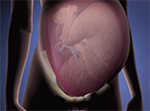The first stage is the progressive thinning (also called effacement) and dilation (opening) of the cervix (neck or opening of the uterus/womb). This stage starts with contractions and ends when the cervix is fully dilated at 10 centimetres (cm).
Labour and Birth
Overview of the three stages of labour
What is labour?
In a nutshell, labour can be described as the process by which a woman gives birth. Labour can start either spontaneously, i.e. by itself, or it can be induced, i.e. started artificially in hospital by medical assistance. Labour may need to be induced for a number of reasons and those will be examined in the chapter on Induced labour.
Spontaneous or normal labour is characterised by the onset of regular, painful contractions that result in the birth of the baby (or babies) and passage of the placenta and membranes through the birth canal. It starts somewhere between 37 and 42 weeks gestation and the whole process can take up to 18-24 hours. This timeframe is only indicative because the length of time will vary among women, depending on individual circumstances. With the advent of active management of labour, few women are in established labour for more than 12-14 hours. The process of labour is divided into three sequential stages:
The second stage is the birth of the baby. This stage starts when the cervix is fully dilated at 10 cm and the baby descends through the birth canal, and is usually accompanied by urges to push or bear down. It is completed with the birth of the baby.
The third stage is the birth of the placenta and membranes (afterbirth). This stage starts after the birth of the baby and finishes when the placenta and membranes are completely expelled.
Video

Click on the thumbnail to view a video on the three stages of labour, based on one particular woman’s experience of labour and birth.

